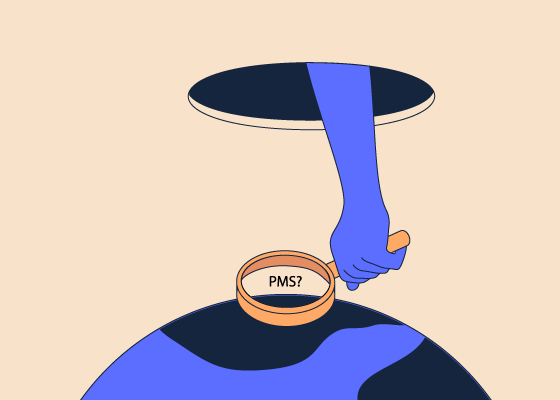For all too many women, endometriosis is a term they have never heard of. However, there are over 190 million women worldwide affected by this condition (1). In the past 50 years, the number of people diagnosed with endometriosis has been increasing, while the age of diagnosis has been decreasing (2). More young people than ever are being diagnosed with endometriosis, although so much is still not understood about the disorder. Luckily, many people are committed to raising awareness for this condition, which not only affects the quality of life but can also threaten a woman's fertility.
Therefore, it is crucial to diagnose it as early as possible. It is, however, not always easy, because sometimes it does not cause any symptoms, and in other cases the pain it causes coincides with menstruation, making it go unnoticed.
What is endometriosis?
Endometriosis is a syndrome in which uterine lining tissue grows outside of the uterus (3). This endometrial tissue is most commonly found in the ovaries, the fallopian tubes, and within the pelvis. This tissue has even been found as far as in the lungs (4). When inside the uterus, this tissue is called the endometrium and is the innermost layer of the uterus. Every cycle it grows to prepare for pregnancy and then ultimately sheds during menstruation. For women with endometriosis, this endometrial tissue follows the same process outside of the uterus. When the endometrial tissue sheds, the blood is released into the pelvic cavity, causing inflammation (1). After the endometrial tissue sheds, the cells involved in the process undergo apoptosis or programmed cell death. This creates scarring in the regions where the tissue resides, contributing to one of the most commonly noticed symptoms among endometriosis-sufferers: pain (1).
What are the symptoms?
While the most noticeable symptom of endometriosis is pain, it is not universally experienced. The most common symptoms of endometriosis include:
-
Dysmenorrhea: Pain during menstruation
-
Dyspareunia: Pain during or after sexual intercourse
-
Dyschezia: Pain during defecation
Other symptoms include heavy periods, pain in the pelvic region, and difficulty getting pregnant (1). More on fertility and endometriosis below. First, let’s talk about the role hormones play in this condition.
What role do hormones play?
The hormones that control the menstrual cycle are believed to also play a role in endometriosis. During a normal menstrual cycle, the ovaries produce estrogen which stimulates endometrial growth. Endometriosis is an estrogen-dominant condition, and women with higher estrogen levels typically have stronger symptoms (5) The endometrial tissue is affected by these higher estrogen levels, triggering chemicals called prostaglandins which create pain and inflammation.
The role of progesterone in endometriosis is still mostly unknown. Some progesterone-based therapies have shown positive results in decreasing pain for patients, but their results widely vary (6).
Many patients naturally develop progesterone-resistance in their endometriosis. This is believed to happen because progesterone receptors levels lower, decreasing overall progesterone levels. This creates a hormonal imbalance of high estrogen levels and low progesterone levels, leading to more pain and inflammation (7).
How do you get it?
The exact mechanism for acquiring endometriosis is still unknown, however, there have been advances in understanding the genetic component of it. Genetic studies have shown that the syndrome often appears in clusters in families and that the inheritance occurs in a polygenic and multifactorial nature. This means that the syndrome is caused by a combination of multiple genes and environmental effects (8).
A theory that is still widely accepted today is Sampson’s 1927 theory on retrograde menstruation. Retrograde menstruation occurs when period blood flows the wrong way, going through the fallopian tubes into the abdominal cavity, creating inflammation (9). While this is considered a viable explanation for endometriosis, the fact remains that approximately 90% of women experience retrograde menstruation during their lives, while very few of them actually have endometriosis. It remains to be seen why only 10% of women develop the disorder under this theory, and researchers remain focused on solving this challenge. New developments in this field also target stem cells as a possible explanation for this disorder (12).
How common is it?
Endometriosis may be more common than the official numbers tell us. Although 5-10% of women of reproductive age have been diagnosed with the disease, over 20% of those women are asymptomatic. This means that there are probably many more women with endometriosis that do not know they have it.
The trouble in diagnosing endometriosis lies in the fact that the only conclusive diagnosis can be made by visually seeing the endometrial lesions. This is done by laparoscopy - a surgery in which a camera is inserted into a small incision near the pelvis. The combination of the difficulty in officially diagnosing it is exacerbated by the fact that many symptoms coincide with menstruation, leading doctors to see the symptoms as normal.
How is it treated?
The main goals of endometriosis treatment are to relieve pain, slow endometrial growth, and improve fertility.
-
Over-the-counter painkillers are often recommended for women experiencing pain.
-
Hormonal contraceptives are often the first suggestion for endometriosis treatment to slow endometrial growth, especially progesterone-based treatment. Hormonal birth control thins the uterine lining, which makes the endometrial tissue outside the uterus thinner as well in women with endometriosis. It does this by reducing or stopping production of estrogen in the body. Although this is a suitable treatment for some, women who are trying to conceive cannot use it
-
GnRH agonists are another type of possible endometriosis treatment. This medication mimics menopause by fully halting the production of estrogen in the body. This triggers menopausal side-effects, such as hot-flashes.
-
Finally, surgery can also be used as a treatment for cases of endometriosis. There are two main types of surgeries often carried out: laparoscopy and hysterectomy. In a laparoscopy, a small incision is made in the pelvis and the doctor operates a camera to find and remove the endometrial tissue. If this surgery is not successful, a hysterectomy can be performed. This surgery is major and cannot be reversed. In it, doctor’s remove a woman’s uterus. In the case of endometriosis, the ovaries are commonly removed as well.
For women with endometriosis who want to have children in the immediate future, it can be very difficult to find a treatment that works for their bodies and for their plans to conceive. However, endometriosis does not necessarily mean a woman is infertile.
How does this affect fertility?
The endometrial tissue produced outside of the uterus has been found in many places in women with endometriosis: the bladder, colon, fallopian tubes, and even the lungs (4). The location of this tissue affects the types and severity of the symptoms. Thirty to fifty percent of women with endometriosis also suffer from infertility (11).
In the case that this tissue attaches, grows, and sheds on the fallopian tubes, this can lead to scarring and blockages on the fallopian tubes. The fallopian tubes are a critical part of the reproductive system, as the egg passes through them on its journey from the ovaries to the uterus. If the fallopian tubes are blocked, fertilization (sperm meets egg) is not possible.
For women with endometriosis who are infertile, there are still options. Firstly, the laparoscopy mentioned above can help remove tissue and scars from the fallopian tubes or other critical areas. Additionally, in-vitro fertilization can be still used for women with endometriosis. It is important to note that the estrogen levels created by IVF can cause endometriosis flare-ups, and also that studies have found that IVF success correlates negatively with endometriosis severity (10). This means that the worse the endometriosis diagnosis is, the less likely it is that IVF will be successful.
Where do we go from here?
Endometriosis is a complex and unknown disorder that requires much more research to better understand. Compared to similar conditions, endometriosis research is severely underfunded. However, in 2020 the US Congress doubled the amount of funding allocated to endometriosis research, coming to a total of 26 million USD. The focus of this research lies in new diagnostic techniques, a better understanding of the mechanism of the disease, and novel treatment techniques.
The impact of endometriosis extends further than its symptoms and has an everyday effect on affected individuals. As is the case with other people suffering from chronic illness, endometriosis can take a toll on one’s personal and professional life.
One of the most challenging aspects of endometriosis is dealing with symptoms before an actual diagnosis has been given. Tracking your symptoms and your menstrual cycle can be a very helpful tool to help understand and contextualize the situation. For this, inne is here for all people who menstruate to support their journey of better understanding their menstrual cycles in all of its beauty, pain, and distinctiveness.
References
-
Zondervan KT, Becker CM, Missmer SA. Endometriosis. N Engl J Med 2020; 382:1244-56.
-
Birnbaum, L. S., & Cummings, A. M. (2002). Dioxins and endometriosis: a plausible hypothesis. Environmental Health Perspectives, 110(1), 15–21. https://doi.org/10.1289/ehp.0211015
-
World Health Organization (WHO). International Classification of Diseases, 11th Revision (ICD-11) Geneva: WHO 2018.
-
Huang, Haidong et al. “Endometriosis of the lung: report of a case and literature review.” European journal of medical research vol. 18,1 13. 1 May. 2013, doi:10.1186/2047-783X-18-13
-
Chantalat, Elodie et al. “Estrogen Receptors and Endometriosis.” International journal of molecular sciences vol. 21,8 2815. 17 Apr. 2020, doi:10.3390/ijms21082815
-
Bulun, SE: Endometriosis, Zeitschrift: NEW ENGLAND JOURNAL OF MEDICINE, Ausgabe 360 (2009), Seiten: 268-279
-
Patel, B. G., Rudnicki, M., Yu, J., Shu, Y., & Taylor, R. N. (2017). Progesterone resistance in endometriosis: origins, consequences and interventions. Acta Obstetricia Et Gynecologica Scandinavica, 96(6), 623–632. https://doi.org/10.1111/aogs.13156
-
Hansen, Keith A, and Kathleen M Eyster. “Genetics and genomics of endometriosis.” Clinical obstetrics and gynecology vol. 53,2 (2010): 403-12. doi:10.1097/GRF.0b013e3181db7ca1
-
VAN DER LINDEN, P. J. Q. 1996. Theories on the pathogenesis of endometriosis. Human Reproduction, 11, 53-65.
-
AlKudmani, B., Gat, I., Buell, D., Salman, J., Zohni, K., Librach, C., & Sharma, P. (2018). In Vitro Fertilization Success Rates after Surgically Treated Endometriosis and Effect of Time Interval between Surgery and In Vitro Fertilization. Journal of Minimally Invasive Gynecology, 25(1), 99–104. https://doi.org/10.1016/j.jmig.2017.08.641
-
Counsellor VS. Endometriosis. A clinical and surgical review. Am J Obstet Gynecol. 1938;36:877.
Sasson, Isaac E, and Hugh S Taylor. “Stem cells and the pathogenesis of endometriosis.” Annals of the New York Academy of Sciences vol. 1127 (2008): 106-15. doi:10.1196/annals.1434.014




